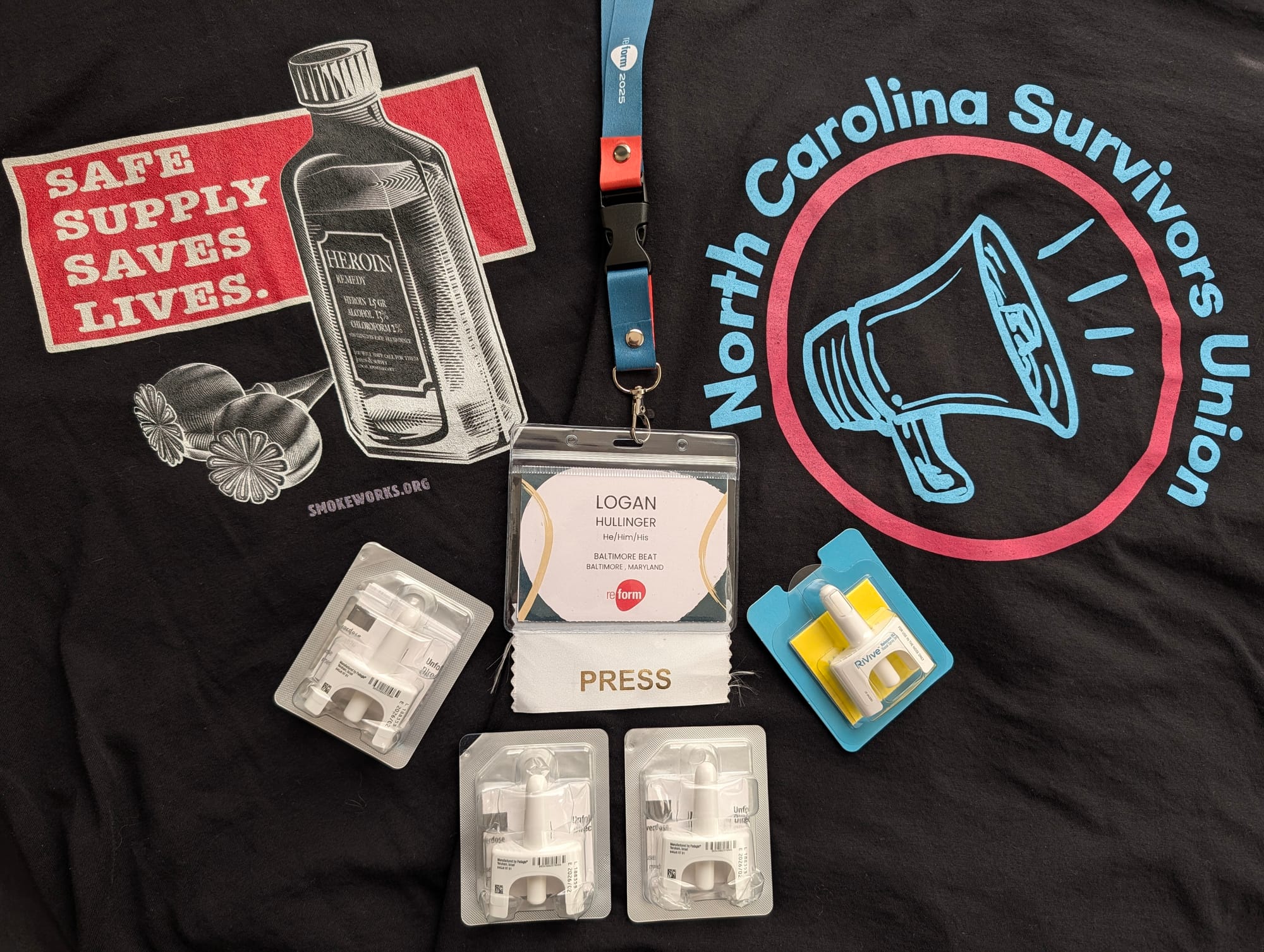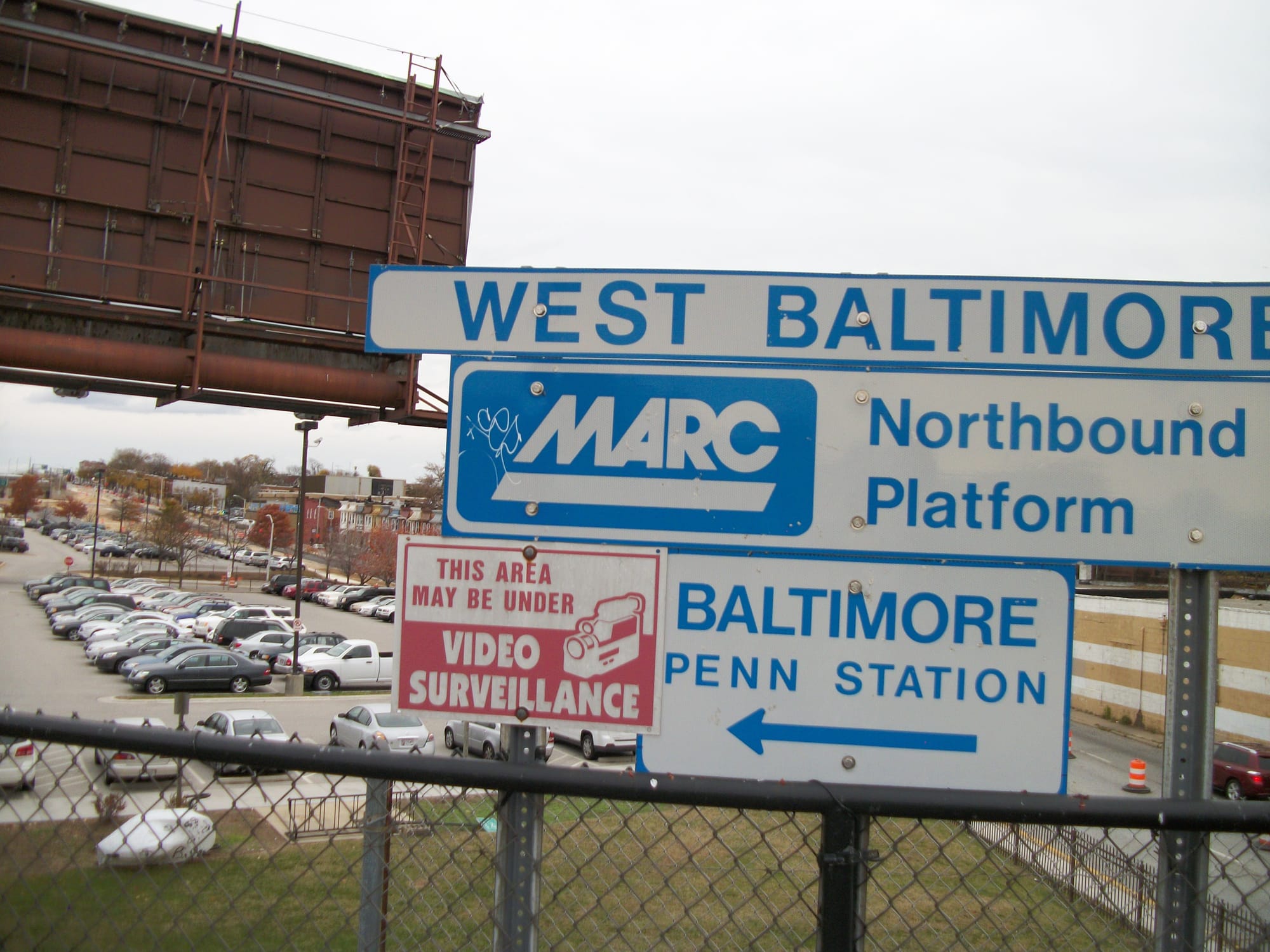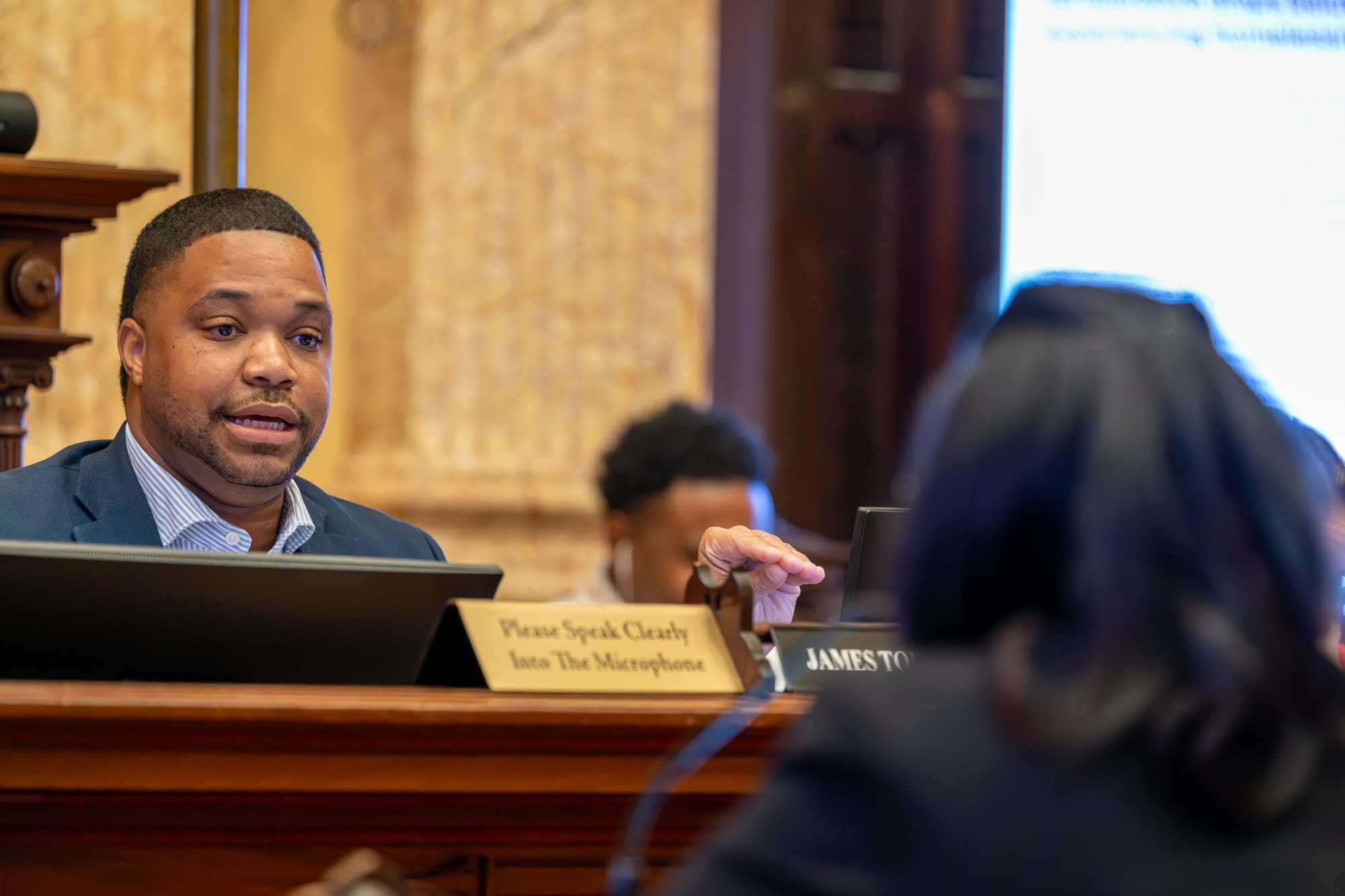
At first glance, it may seem that the War on Drugs has all but disappeared in Baltimore. The decades-long campaign decimated Black neighborhoods and fueled mass incarceration in the city under the guise of public safety.
From more than 7,000 arrests in 2015 to less than 2,000 in 2024, the number of people being arrested for drug crimes has plummeted. Public officials seem to have formed a consensus — one reflected more so in words than in actions — about the importance of harm reduction in place of a punitive approach to drug use.
Look closer, however, and it’s evident that the driving force behind the drug war has only gotten worse.
In a staggering indictment of policing in Baltimore, a Baltimore Beat analysis of police data shows that nearly all people arrested and charged with drug crimes in Baltimore are Black — even though studies show that drug use rates among the Black population are similar to those of other races. Meanwhile, a change in priorities at the State’s Attorney’s Office caused low-level drug charges to surge. Police are slated to receive an increase to their already exorbitant budget in part to crack down harder on drug crimes, while the health department’s funding could be decimated as they try to help those who use them.
At the same time, death rates among older Black men skyrocketed in the last decade.
The Beat’s analysis covered tens of thousands of misdemeanor and felony drug arrest records obtained from the Baltimore Police Department through a Public Information Act request. The dataset, spanning from 2015 to 2024, was sorted by race and ZIP code and analyzed in conjunction with publicly available overdose data and population data from the American Community Survey, an annual demographics survey conducted by the U.S. Census Bureau.
Lawrence Grandpre, the policy director of Leaders of a Beautiful Struggle, a grassroots, Black-led think tank in Baltimore, said the data demonstrates how “racialized social control” has maintained racial hierarchies and inequality in Baltimore.
“A couple of things are happening. One is that it’s muscle memory for cops,” Grandpre said. “You need to continuously justify the massive amounts of money that they take from the community.”
“There is also racialized stigma around the notion of the Black drug addict and the Black drug seller, the Black drug seller being a driver of violence through narratives that reach back but also the idea of the Black addict as uniquely dangerous in their intoxication, as opposed to … public health frames of empathy and solidarity around white drug addicts.”
In 2015, the same year Freddie Gray died at the hands of the Baltimore Police Department and the city erupted in calls for criminal justice reform, about 84% of those arrested on drug charges — including both misdemeanors and felonies — were Black people.
That number peaked at 96% in 2021, the same year the city was devastated by the most fatal overdoses ever recorded in a single year. A little over 1,000 deaths that year were attributed to overdoses, more than two-thirds of whom were Black, according to data from the Maryland Department of Health.
In 2024, 92.5% of those arrested for drug charges were Black.
Catherine Tomko, a social scientist at the Johns Hopkins Bloomberg School of Public Health, said the extent to which Black Baltimoreans are arrested is disproportionately high, even in the context of racist policing nationwide. The most recent U.S. Census Bureau figures show the city is 60% Black.
“Considering the history of policing in Baltimore, I am not completely surprised by those numbers,” Tomko said.
“The inflection point obviously is the death of Freddie Gray and the uprisings that happened. It created a big spotlight on Baltimore policing and its practices. And when the Department of Justice came in and investigated, they found really egregious, racist practices that targeted the Black community.”
Baltimore saw a spike in violent crime and homicides after Gray died in police custody, with a significant decline seen only in the past couple of years, as national numbers also dropped. The part of the story that tends to be overlooked is the concurrent — and intertwined — surge in overdose deaths.
The year of Gray’s death, fatal overdose rates of white and Black men ages 55 and older were nearly identical, data from the Maryland Department of Health shows. The death rate among Black men in that age range skyrocketed as years passed.
By 2023, the death rate of older Black men reached an all-time high of 697 deaths per 100,000 people, more than doubling that of white men. Baltimore saw a historic drop in overdose deaths the following year, yet the death rate for Black men remained about 88% higher than white men.
“For many people, they don’t have access to methadone or anything to keep their tolerance up,” Grandpre said. “So when they get out of jail, they have a lower tolerance for this very toxic drug supply, setting them up for a fatal overdose.”
“On top of that, you just have general life instability, where you may have some tentative employment or housing, but the criminal justice system puts you in a position where those things become more tenuous. Those things can put you at risk of an overdose.”
Policing in Baltimore can’t be talked about as simply an effort to keep communities safe. Its impact on public health and overdose prevention efforts in the city has been devastating.
Arrest data analyzed by the Beat demonstrates that drug enforcement over the past 10 years has focused on majority-Black neighborhoods located in east and west Baltimore, which are also the areas with some of the highest fatal overdose rates in the city.
In poorer, majority-Black neighborhoods such as those in ZIP code 21216 in West Baltimore, as many as 98% of people arrested on drug charges over the last 10 years were Black, according to calculations based on demographic data from the 2023 American Community Survey.
Even in areas with majority-white populations, such as ZIP codes 21224 in Southeast Baltimore, the majority of people charged with drug crimes in the past decade were Black, according to the data. That area also has a relatively high overdose death toll.
(The arrest numbers could fluctuate slightly, as some arrests contained errors in ZIP codes. For example, more than 120 ZIP codes were simply listed as “0.” Gender data was not included in the dataset, though it’s well-documented that Black men are arrested and incarcerated at significantly higher rates.)
Despite the severity of the growing overdose crisis, the spotlight largely remained fixated on violent crime. Yet, like homicides, fatal overdoses have disproportionately affected Black communities over the years.
Cops and city officials have denied racial profiling and claimed the drug arrest data shows the impact of strategic policing that focuses on where the bulk of crime occurs.
“The BPD prioritizes enforcement efforts on drug-related activities that contribute to violence, such as trafficking and distribution by organized criminal networks. Enforcement strategies continue to evolve, focusing on dismantling open-air drug markets and addressing addiction through a public health lens, including diversion programs and drug court. Officers also address cases where substance use contributes to broader public safety concerns,” BPD spokesperson Lindsey Eldridge said.
Enforcement efforts tend not to have the intended effect of curbing fatal overdoses or violent crime, according to numerous studies.
In fact, they may have the opposite impact, a study in the International Journal of Drug Policy shows.
"From an evidence-based public policy perspective and based on several decades of available data, the existing scientific evidence suggests drug law enforcement contributes to gun violence and high homicide rates and that increasingly sophisticated methods of disrupting organizations involved in drug distribution could paradoxically increase violence,” the study found.
A 2023 study conducted by Harvard University argued that drug enforcement can also increase overdose death rates by disrupting the drug supply and pushing drug users toward riskier sources, a phenomenon known as the “Iron Law of Prohibition.”
Against the backdrop of decades of drug-war propaganda, nixing enforcement in favor of other approaches may seem radical to some. Yet harm reductionists in Baltimore and beyond recognize the damage that heavy-handed policing has caused for decades, advocating instead for a compassionate, evidence-based approach to drug policy.
“The War on Drugs is fundamentally a system of punishment and control, not care. It hasn’t reduced drug-related deaths, use, or manufacturing; but it has devastated communities, especially Black and Brown ones,” said Darci Curwen-Garber, policy manager of the Baltimore Harm Reduction Coalition.
“When we use punitive drug laws to ‘remove the problem,’ what we’re really doing is removing people — disappearing them through incarceration, policing, and stigma.”
City officials, however, have found themselves unable — or unwilling — to let go of punitive drug enforcement and the millions of dollars it takes to bankroll the cops who carry it out.
Mayor Brandon Scott’s budget, approved by the City Council on June 16, includes a more than $20 million increase to the police department’s budget for the upcoming fiscal year, bringing its total to almost $613 million. As of 2020, the city spent more per capita on its police department than any other U.S. city, according to a study by the nonprofit Vera Institute of Justice.
At a budget hearing earlier this month, Police Commissioner Richard Worley touted an 11% increase in felony drug arrests and a 28% increase in misdemeanor arrests since last year. More money is needed, he argued, to continue these efforts and cover overtime costs.
The fiscal plan also includes a $7 million cut to the health department, marking a 3.5% decrease from the year prior. At $201 million, its budget is less than one-third of that of the police department — and nearly half of that comes from federal funding that could be lost because of President Donald Trump’s barrage of cost-cutting measures.
Those impacted by drug enforcement spoke to the Beat about a pattern of targeted enforcement that often creates a carceral cycle for Black Baltimoreans.
Eric Monroe grew up in East Baltimore, where both drug arrest rates and fatal overdose rates remain relatively high. Like many Black youth growing up in poverty in Baltimore, Monroe followed the lead of his environment.
His parents and other adults in his life were “caught up in the drug life,” and when he and his friends needed money, selling drugs seemed like the obvious way to get it.
Monroe soon faced drug charges, leaving him with a criminal record in his teens. He served his first stint in prison at 19.
Monroe, now 44, said he regrets his actions, though he spoke of the feeling of hopelessness as a young Black person and how that feeling can deter people like himself from fighting charges, even in the absence of solid evidence.
“If I get caught with a drug charge and a court date, you feel like you’ve already been convicted,” he said.
“There’s a stigma for us African American people that we are guilty until proven innocent. You can’t win because they are the authorities. They have the last say in how this can end up. Either they can let you walk away or make the rest of your life miserable.”
The police didn’t let Monroe walk away. The damage was done, and the initial drug charges escalated into more serious crimes and longer sentences as he sought approval from the streets.
Though he is free today and on a better path, it remains part of his history.
Terry Speaks, who got out of prison on a 10-year sentence in 2024 for robbery charges, became addicted to pills at a young age, and turned to what he was surrounded by to feed his habit: selling. The cops eventually caught up to him as he attempted to manage his addiction.
Speaks, now 50 and a certified peer recovery coach, works as a leadership development organizer for the nonprofit Out For Justice, a Baltimore-based nonprofit that helps reconnect individuals to society post-incarceration. He grew up in Park Heights, an area with some of the most overdose deaths and drug arrests in the city, and Woodlawn. He echoed Monroe’s feelings of hopelessness at a young age.
“I feel like I was railroaded when I was young,” Speaks said. “My family didn’t have a lot of money. And when I was in prison, they didn’t offer any help or nothing. If you didn’t take it upon yourself to rehabilitate yourself, you didn’t get any type of guidance in prison at a young age. It was just a continuous cycle.”
A leg injury he suffered in adulthood fueled Speaks’s addiction. He resorted to robbery to fund his substance use, escalating his crimes in pursuit of drugs. His choices perpetuated a carceral cycle similar to Monroe’s.
As Baltimore residents deal with the lasting impact of drug prohibition, organizations like the Baltimore Harm Reduction Coalition, Charm City Care Connection, and Bmore POWER have stepped in to work alongside the health department to ensure those who use drugs stay alive.
Together, they’ve offered sterile syringes and safe smoking kits to prevent the spread of diseases like HIV. They’ve distributed innumerable doses of naloxone, which reverses overdose deaths, along with test strips for fentanyl and xylazine — the latter of which is increasingly found in the drug supply and is resistant to naloxone.
To prevent further overdose deaths, these organizations are calling for the city to do more, perhaps most notably by implementing overdose prevention centers (OPCs) and decriminalizing drug “paraphernalia.”
By giving drug users a safe, judgement-free place to use substances — without having to worry about cops — OPCs would reduce overdose deaths, they argue. They also argue that paraphernalia decriminalization would allow people to utilize syringe service programs without fear that they could be arrested for possessing the supplies they receive there.
Bills in the Maryland General Assembly to implement those measures have repeatedly died in committee in recent years.
“So many of the overdoses and drug harms that are happening [in Maryland] happen in Baltimore City,” said Tomko, whose studies at the Johns Hopkins Bloomberg School of Public Health focus on drugs and marginalized populations. “So I do think that some of it is a racist idea of, ‘Whatever happens to that community happens to that community,’ so there isn’t as much of a political will and urgency.”
Mayor Scott has the authority to unilaterally impose measures such as OPCs, though he has repeatedly declined to comment on the matter despite naming both pieces of state legislation as two of his 21 “legislative priorities” this year.
Meanwhile, State’s Attorney Ivan Bates has done away with the de facto decriminalization policy instituted by his predecessor Marilyn Mosby in 2020, taking the city back to the days of former Mayor Martin O’Malley and zero-tolerance policing.
In Bates’s first year in office in 2023, all drug charges surged to 4,913, a 91% increase over the year prior. Misdemeanor drug charges, which were the subject of the de facto decriminalization policy, increased nearly 20-fold, from 113 to 2,108.
Racial disparities in arrests worsened under both states’ attorneys.
Though data on racial demographics of those incarcerated in Baltimore is limited, a 2022 report by Mosby’s office and researchers from the University of Maryland and Howard University found that Black defendants “face more serious charges and are overrepresented in violent, firearms and drug offenses” and “more than 1 in 3 cases involve drug charges as the most serious offense.”
Heather Pfeifer, executive director of the University of Baltimore’s School of Criminal Justice, said the new arrest data raises questions about the city’s approach to drug enforcement.
“If we don't have an honest conversation about this, it jeopardizes the legitimacy of the relationship between the police and the community.”
Both the mayor and Bates would not directly address questions about racial profiling in policing and prosecution. Bates’s office declined to comment, and Scott pointed to a historic decline in homicides and progress in the police department’s 2017 consent decree.
However, eight years later, a federal judge has found the police department to be fully compliant in only five of 17 sections of the decree. Notably, it has not been found in full compliance with sections dealing with discriminatory practices in stops, searches, and arrests.
“While BPD is committed to fair and impartial policing, it recognizes the need to address disparities in law enforcement outcomes,” Eldridge said. “The department continues to implement bias training, increase transparency in data reporting and expand community engagement efforts to ensure equitable policing practices.”
Eldridge pointed the Beat to a November 2023 assessment by the BPD’s Consent Decree Monitoring Team, which noted that there was “no statistically significant pattern” in regard to race among cases that lacked probable cause.
The same assessment says, “Compared to the overall Baltimore population, arrest subjects in the reviewed samples were disproportionately Black.”
In 2025, it’s unclear how — or if — Baltimore will break from its history of punitive drug policy.
Despite pouring money into the police department while cutting funds to the city’s public health authority, the mayor and city officials have vowed to more strongly embrace harm reduction initiatives.
A silver lining may be imminent thanks to hundreds of millions of dollars in opioid restitution funds that the city has won from opioid-related lawsuits. However, the city will likely receive less than it had anticipated.
On June 12, a judge rejected the city’s request for two opioid distributors to pay $5.2 billion to cover the city’s abatement plan and also reversed a jury verdict in the first phase of the trial that awarded the city $266 million in “public nuisance” damages.
The city must decide by July 7 if it will accept a massive cut to its winnings to avoid a new trial, after which abatement would be re-evaluated. With the development, Baltimore’s total winnings from lawsuits could end up significantly less than the BPD’s annual budget — and the opioid money is meant to be spread out over 15 years.
Of the roughly $37 million in restitution funds Baltimore has already received and is slated to allocate in the upcoming fiscal year, more than $3 million has already been proposed for supplanting existing funding streams instead of building on current harm reduction efforts. Public health experts have strongly cautioned against the practice, including the Johns Hopkins University Bloomberg School of Public Health.
Meanwhile, the police and public officials continue to boast about drug busts, flaunting photos of seized weapons and drugs such as fentanyl. On Capitol Hill, the synthetic opioid has also become a rallying cry for President Trump and his administration.
Republicans have sought to designate fentanyl as a “weapon of mass destruction” and have weaponized it to demonize immigrants and other minorities — echoing the drug-war rhetoric of former presidents Richard Nixon and Ronald Reagan.
And now Democrats, just as former President Bill Clinton did with the 1994 Crime Bill, are joining in to expand mandatory minimum sentences with the HALT Fentanyl Act.
The administration is pushing to slash billions in funding for local health departments and freeze grants to entities such as harm reduction organizations, putting their overdose prevention efforts in jeopardy.
“If we’re serious about saving lives, then our drug policies need to be designed with one clear goal: to protect and support all people who use drugs,” said Curwen-Garber, policy manager of the Baltimore Harm Reduction Coalition.
“Until that happens, our loved ones — and yours — will keep dying.”








Comments